#limon-tagetes
Note
I dont know why everyone is talking about dad names but
My dad's name is Medardo 💀 He has a secret catholic second name though, because some time ago a lot of people used to have a completely different extra name when getting baptized.
i have catholic family and havent heard of that, is it like... an illegal middle name??
#og post#ask#limon-tagetes#we're talking about dad names because i asked what the worst name is and a lot of what people were saying were the names of dads
7 notes
·
View notes
Note
The throwing him Thursday post now has 10k notes thanks to your weekly reblogs.
I know : ) i even made a celebration post. With your help, we might even reach 20k 💯‼️🔥😎💥
3 notes
·
View notes
Photo
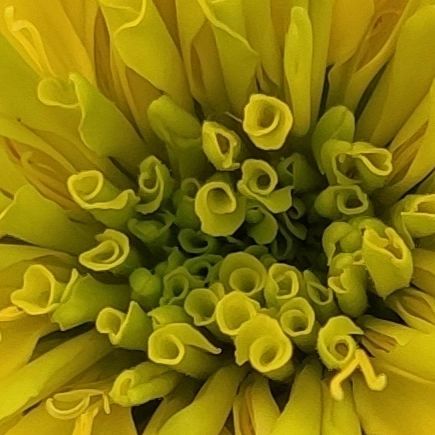
Particolare del fiore Tagete limone. Serra San Benedetto, PD https://www.instagram.com/p/CcM782lN8iV/?igshid=NGJjMDIxMWI=
0 notes
Text
Hangi çiçek hangi ayda ekilmelidir?
Yemyeşil bir bahçe veya renk renk çiçekleri ile ta uzaktan bile fark edilen cıvıl cıvıl bir balkona sahip olmak birçok insanın hayali olabilir. Böyle bir heves veya merakı olmayan insanlar bile güzel bitkilerin yer aldığı bahçe veya balkonlarda bulunmaktan zevk alır. Ve bana kalırsa bitkilerin, insanın içini kıpırdatmak ile ilgili bildiği bir şey var sevgili okur.

Bitkiler sağlıklı bir biçimde büyüyebilmesi için besin takviyesi, sulama, budama ve toprağın pH kontrolünün yapılarak dengelenmesi gibi faktörler oldukça önemlidir. Özellikle çiçeklerin sağlıklı ve verimli büyüyebilmeleri için göz önünde bulundurulması gereken bir diğer faktör ise ekim mevsimidir. İç mekan bitkileri için de dış mekan etkileri için de ekim zamanı büyük bir etkiye sahiptir. Buradan yola çıkarak yaptığımız araştırmalardan edindiğimiz bilgilere göre çiçeklerin ekim zamanı için en ideal olan ayların bir listesini hazırladık.
Hangi çiçek hangi ayda ekilmelidir?
Ocak ayında hangi çiçekler ekilmelidir?
Zorlu kış koşullarına sahip aylardan biri olan ocak ayında iyi bir yetiştirici olabilmek için dikkat edilmesi gereken en önemli şey, bitkilerin korunmasına dikkat etmektir. Bitkileri korumak için toprağın üzerine saman, turba ve bitki yaprağı yığınları serilebilir. Aynı zamanda bitkileri sulama periyotlarının da buna göre düzenlenip, azaltılması gerekir. Ocak ayında ayında ekilebilecek çiçeklerden bazıları şunlardır;
Ametist
Lobelya
Begonya
Pelesenk
Camgüzeli
Sabır ağacı
Hercai menekşe
Şubat ayında hangi çiçekler ekilmelidir?
Şubat, gül fidanlarının budandığı ay olarak bilinir. Çim alanlarda kış gübresi şubat ayı içerisinde tamamlanmalıdır. Ayrıca havalar soğuk olsa da şubat, ilkbahar hazırlıklarını yapmaya başlanabilecek aylardandır. Bahçe ve balkon düzenlemek için ideal bir zaman olabilir. Şubat ayında ekilebilecek başlıca çiçekler şunlardır;
Buz çiçeği
Bodur mavi çan
Karagözlü suzan
Bodur kolyoz (Coleus)
Gayret çiçeği (Gaillardia)
Mart ayında hangi çiçekler ekilmelidir?
Mart ayı, oldukça sert mevsim şartları görülebilen dolayısıyla da bitkilerin korunması gereken aylardandır. Önceki aylarda bitkileri korumak için toprak üzerine serilen saman, turba veya bitki yığınlarının mart ayında yenilenmesi gerekebilir. Mart ayında ekilebilecek başlıca çiçekler şunlardır;
Deliotu
Flos çiçeği
Latin çiçeği
Gayret çiçeği
Hüsnüyusuf
Peygamber çiçeği
Kadife (Tagetes Patula)
Zinya (Kirli Hanım çiçeği)
Nisan ayında hangi çiçekler ekilmelidir?
Yaz hazırlıklarına başlamak için en ideal ay, nisan ayıdır. Nisan ayında sağlıklı bitkiler yetiştirebilmek için dikkat edilmesi gereken nokta ise bitkileri doğrudan güneş ışığına maruz bırakmamaktır. Çiçeklerinizi doğrudan güneşe maruz kalmayacak şekilde konumlandırabilir ya da gölgelenme örtüleri kullanabilirsiniz. Nisan ayında ekilebilecek çiçeklerden bazıları şunlardır;
Mine
Karanfil
Petunya
Ateş çiçeği
Cam güzeli
Yıldız çadırı
Gündüz sefası
Şeflera (Schefflera)
Godetya (Yer açelyası)
Mayıs ayında hangi çiçekler ekilmelidir?
Bir önceki aya kıyasla güneşin daha hissedildiği mayıs ayında da çiçekleri güneş ışığından korumak önemlidir. Dolayısıyla evde yetiştirilen çiçeklerin doğrudan güneş ışığına maruz kalmayacak şekilde konumlandırılmalı veya gölgelenme işlemi mutlaka yapılmalıdır. Mayıs ayında ekilebilecek başlıca çiçekler şunlardır;
Müge
Açelya
İnci çiçeği
Sardunya
Hor çiçeği
Haziran ayında hangi çiçekler ekilmelidir?
Haziran ayı denince akla ilk gelen çiçek, güldür. Aynı zamanda haziran, tırmanıcı çiçeklerin ekilmesi ve rafya ipi ile güçlendirilmesi gereken aydır. Haziran ayında ekilebilecek başlıca çiçekler şunlardır;
Açelya
Petunya
Ortanca
Sardunya
Kadife çiçeği
Temmuz ayında hangi çiçekler ekilmelidir?
Havaların iyiden iyiye ısınmaya başladığı dolayısıyla da bitkilerin daha fazla suya ihtiyaç duyduğu ayların başlangıcıdır. Temmuz ayında bitkilere verilen su miktarının artırılması gerekir. Ayrıca ayıklama işlemi de bu ay içerisinde yapılmalıdır. Temmuz ayında ayında ekilebilecek çiçeklerden bazıları şunlardır;
Açelya
Papatya
İpek otu
Ortanca
Hanımeli
Manolya
Sarı açelya
Ebegümeci
İndigo ağacı
At kestanesi
Amber çiçeği
Yalancı karanfil
Erkeçsakalı çiçeği
Ağustos ayında hangi çiçekler ekilmelidir?
Ağustos, yazlık çiçekler için gübreleme yapılacak son aydır. Ağaç nakilleri ise ikinci haftadan itibaren yapılmalıdır. Yabani ot ayıklama, ilaçlama, sulama işlemleri yapılabilir. Aynı zamanda ağustos, sonbahar hazırlıklarına başlamak için ideal aylardandır. Ağustos ayında ekilebilecek başlıca çiçekler şunlardır;
Lale
Limon
Zambak
Lavanta
Sardunya
Sümbülteber
Eylül ayında hangi çiçekler ekilmelidir?
Pek çok bölgede ılıman geçen eylül, ay sonuna doğru soğukların etkili olabileceği bir aydır. Dolayısıyla soğuk havalara karşı bitkileri korumak için hazırlık yapmak için en ideal zamandır. Eylül ayında toprağın organik ya da mineral gübre ile gübrelenmesi ve temizlenmesi gerekir. Eylül ayında ekilebilecek ayında ekilebilecek çiçeklerden bazıları şunlardır;
Lale
Sümbül
Aster çiçeği (Yıldızpatı)
Ekim ayında hangi çiçekler ekilmelidir?
Ekim, toprak işlemesi için en ideal aydır. Ay boyunca toprak havalandırılmalı ve kış hazırlıkları yapılmalıdır. Organik gübre, ekim ayı içerisinde verilmelidir. Ekim ayında ayında ekilebilecek çiçeklerden bazıları şunlardır;
Lale
Sümbül
Kardelen
Dağ lalesi
Süsen çiçeği
Allium çiçeği
Arap sümbülü
Çiğdem çiçeği
Ağlayan gelin çiçeği
Kasım ayında hangi çiçekler ekilmelidir?
Kış mevsiminin zorlu hava şartlarının başladığı kasım ayı, çiçeklerin soğuklara karşı korunmasının en önemli olduğu aylardandır. Sonbahar budaması kasım ayı içerisinde yapılmalıdır. Budama işlemi özellikle süs çalıları ve küçük ağaçlar için oldukça önemlidir. Kasım ayında ekilebilecek çiçeklerden bazıları şunlardır;
Nergis
Sümbül
Aslanağzı
Kale bitkisi
Süs lahanası
Allium çiçeği
Hercai menekşe
Aralık ayında hangi çiçekler ekilmelidir?
Aralık, budama işlemlerinin en sık yapıldığı aydır. Ayrıca don olaylarının başladığı ay olduğu için çiçeklerin üzerine koruyucu yaprak örtüsü serilmesi gerekebilir. Aralık ayında ekilebilecek çiçeklerden bazıları şunlardır;
Açelya
Manolya
Çuha çiçeği
Yılbaşı çiçeği
Siklamen çiçeği
Atatürk çiçeği (Ponsetya)
Kış sümbülü (Kış ortancası)
Velhasıl
İçimizi de bulunduğu yeri de güzelleştiren canım çiçeklere sahip olabilmek için dikkat edilmesi gereken bazı noktalar vardır. Ekim zamanı da bunlardan en önemlilerinden biridir. Doğru zamanda doğru çiçek ekimi ve devamında gösterilen ilgi ile güzelleşmeleri güzelleşeceğimiz bir bahçe, balkon veya ufak da olsa cıvıl cıvıl köşeye sahip olabiliriz. Çiçekler yalnızca büyüyüp, oldukları yeri güzelleştirmek ile kalmazlar sevgili okur. Ben, aynı zamanda büyüttüklerine ve güzelleştirdiklerine de inanırım. O yüzden hepimiz için renk kattıkça güzelleşeceğimiz çiçek gibi bir dünya diliyorum. Gülümseme ve sağlık ile kalın.

Hangi çiçek hangi ayda ekilmelidir? yazısı ilk önce Canım Dünya üzerinde ortaya çıktı.
from Canım Dünya https://ift.tt/3uMaZ3p
0 notes
Text
Phototoxic Essential Oils: What You Need To Know
I’ll admit it. When I first started using essential oils, I thought because they were “natural,” they were safe. I did very little research on them other than looking into the basics of how to use them. Thankfully, I mostly used them in homemade cleaning products and DIY skin care recipes, so most times they were properly diluted. No unfortunate peppermint bath experiences here, thank goodness!
Over the years, I’ve become a bit of a stickler for safe essential oil use, especially now that I know more about them. Essential oils are concentrated and strong. Not only that, but it often takes a lot of a plant to make a small amount of essential oil, and I want to be a good steward of the earth’s resources. In my efforts to use essential oils safely, one of the most recent safety concerns I’ve come across is phototoxicity.
If you’re familiar with essential oils, then I’m hoping you already know about phototoxic essential oils and are taking safety measures to avoid phototoxicity. However, if this is something you are not familiar with, I’d like to briefly explain what phototoxicity is, which essential oils are phototoxic, and how you can avoid it.
Phototoxicity 101
Phototoxicity can occur when constituents in certain essential oils (furocoumarins, most often) react when the skin is exposed to UV light. According to aromatherapist, Sheri Siegmund-Roach, the constituents in the essential oil binds with DNA in the skin cells and, once exposed to UV light, cell death and tissue damage occur (Siegmund-Roach, 2016).
Phototoxic reactions can occur anywhere from 1-3 days following exposure to UV light. These reactions often result in inflammation, swelling, blistering, and burned skin. Phototoxic reactions only occur when these oils are applied topically at specific dilutions (more on that below) and exposed to UV light within a 12-18 hour period.
Using phototoxic essential oils in diffusers and personal inhalers are fine. Some people even say these types of oils can be safely added to personal diffuser jewelry. However, I’d use some caution here, especially when it comes to jewelry that comes in contact with your skin such as lava beads and leather bands.
It is also believed that using phototoxic essential oils in skin care products that are washed off, like sugar scrubs, soaps, and shampoos, pose no risk of phototoxicity.
Phototoxic Essential Oils
So which essential oils are considered potentially phototoxic? Glad you asked. The following is a list of phototoxic and potentially phototoxic essential oils as well as a list of citrus essential oils that are not known to be phototoxic.
Phototoxic Essential Oils
Angelica root (Angelica glauca) essential oil
Bergamot (Citrus bergamia) essential oil, cold pressed
Bitter orange (Citrus x aurantium) essential oil, cold pressed
Cumin (Cuminum cyminum) essential oil
Lemon verbena (Aloysia triphylla) essential oil
Fig leaf (Ficus carica) absolute
Grapefruit (Citrus paradisi) essential oil, cold pressed
Lemon (Citrus limon) essential oil, cold pressed
Lime (Citrus aurantifolia) essential oil, cold pressed
Mandarin leaf (Citrus reticulata) essential oil
Opopanax (Commiphora erythraea) essential oil
Rue (Ruta graveolens) essential oil
Taget (Tagetes minuta) essential oil and absolute
Potentially Phototoxic Essential Oils
Clementine (Citrus clementina ) essential oil, cold pressed
Combava fruit (Citrus hystrix) essential oil
Skimmia (Skimmia japonica) essential oil
Angelica root (Angelica archangelica) absolute and CO2
Celery leaf (Apium graveolens) essential oil
Celery seed (Apium graveolens) absolute
Cumin seed (Cuminum cyminum) absolute and CO2
Khella (Ammi visnaga) essential oil
Lovage leaf (Levisticum officinale) essential oil
Parsnip (Pastinaca sativa) essential oil
Non-Phototoxic Citrus Essential Oils
Bergamot FCF (bergaptene- and furocoumarin-free) (Citrus bergamia) essential oil
Bergamot (Citrus bergamia) essential oil, steam distilled
Grapefruit (Citrus paradisi) essential oil, steam distilled
Lemon (Citrus limon) essential oil, steam distilled
Lime (Citrus aurantifolia) essential oil, steam distilled
Mandarin (Citrus reticulata) essential oil, cold pressed or steam distilled
Neroli (orange blossom) (Citrus x aurantium) essential oil
Sweet orange and blood orange (Citrus sinensis), cold pressed or steam distilled
Petitgrain bigarade (orange leaf) (Citrus x aurantium) essential oil
Satsuma (Cold Pressed or Steam Distilled)
Tangelo (Citrus reticulata) essential oil, cold pressed or steam distilled
Tangerine (Citrus reticulata) essential oil, cold pressed or steam distilled
Yuzu Oil (Citrus junos) essential oil, cold pressed or steam distilled
(Tisserand & Young, 2014)
How To Avoid Phototoxicity
In case you’re wondering, no, you don’t have to avoid all phototoxic essential oils like the plague during the summer. However, it is wise to know how to reduce the risk of phototoxicity if you do decide to use them.
First of all, your best bet at avoiding phototoxicity is to stay away from these oils. If that won’t work, try substituting steam distilled essential oils in their place or using these oils in diffusers and personal inhalers only, especially if you are regularly exposed to UV light.
If you do decide to use these types of essential oils, it’s recommended to wait 12-18 hours before exposing yourself to UV light. If you do have to go out, you should cover your skin with fairly thick clothes (light clothing doesn’t provide enough protection). This will ensure that the areas the essential oil was applied to are not exposed to the light. You can also dilute phototoxic essential oils to appropriate levels as well. Each oil has a recommended dilution guideline so you’ll definitely want to look into this closer if you do decide to go this route. You can find some of these phototoxic essential oil dilution guidelines here.
REFERENCES:
Siegmund-Roach, S. (2016). The truth about phototoxic essential oils and how to use them safely. Retrieved from http://bit.ly/2WPVWnn
Tisserand, R., & Young, R. (2014). Essential oil safety: A guide for health care professionals. (Second Edition). United Kingdom: Churchill Livingstone Elsevier.
This post was underwritten by Plant Therapy. All opinions are mine. Plant Therapy offers 100%, pure, undiluted essential oils sourced from some of the top essential oil suppliers in the world. They have single oils and synergy blends as well as a line of synergy blends specific to children. Not only do they offer high-quality essential oils, but they also offer carrier oils, hydrosols, and other essential oil accessories to help you keep yourself and your home naturally healthy.
The post Phototoxic Essential Oils: What You Need To Know appeared first on Growing Up Herbal.
Phototoxic Essential Oils: What You Need To Know published first on https://marcuskeever.blogspot.com/
0 notes
Text
Giardino + cucina = 🧡
Per i pollici verdi la grande soddisfazione non è solo avere un giardino sano e rigoglioso, ma poter sfoggiare grandi ed esotiche collezioni e poter dire “questa pianta ce l’ho solo io!”. Esiste poi un’altra categoria molto particolare, quella dei pollici verdi chef, che nei loro capolavori culinari usano produzioni esotiche del proprio orto.
Questo post è un po’ per loro, ma anche per noi “comuni terrestri” curiosi e intraprendenti. Presentiamo qui qualche specie (lo spazio è sempre poco per raccontare tutto quello che la natura ci offre) che fa bella figura in giardino e in cucina e soprattutto vi invitiamo, come sempre, a piantare di più, ad osare, a cercare nuove piante.
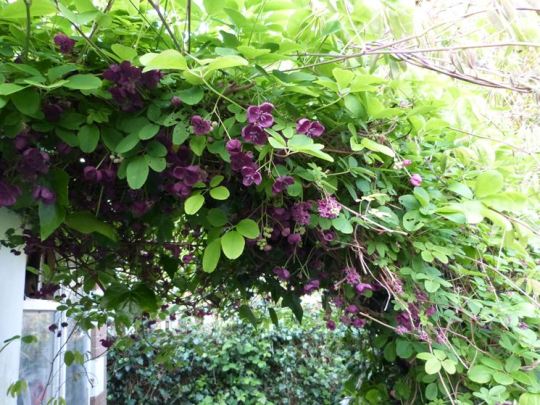
La prima pianta, non l’avreste mai detto che è commestibile, è l’Akebia Quinata (quella della foto). Senza nulla togliere ai soliti rampicanti, questo è fantastico e non molto conosciuto: semi-sempreverde, vigoroso, bei fiori e buon profumo, resistente e versatile. In più i suoi frutti possono essere usati in cucina come dolce o contorno. Ha proprietà analgesica, antinfiammatoria, antiossidante e incentiva la produzione di latte materno.
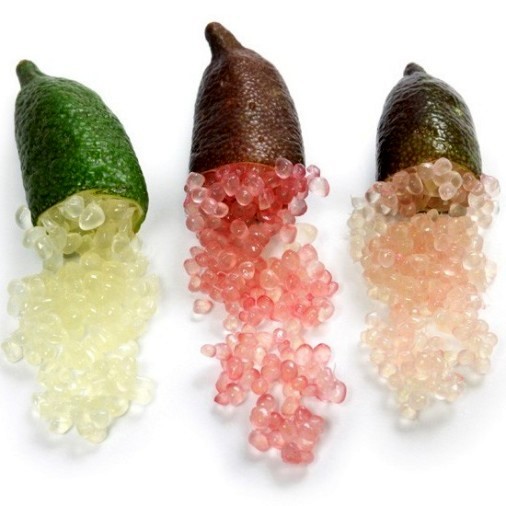
Poi c’è il fascino immortale degli agrumi che, se coltivati in vaso, danno un tocco di romanticismo mediterraneo a terrazzi e giardini. Ce ne sono di tante varietà, insolite e non, solo sul nostro sito sono più di 50. Ma sicuramente la più apprezzata dagli chef è quella del Finger Lime, o Limone Caviale, come elemento decorativo e per il particolare sapore, che ricorda quello del pepe rosa.

Sempre tra i bellissimi e versatili agrumi, abbiamo scelto il kumquat. Bell’alberello, resistente alle basse temperature, dai fiori bianchi e piccoli frutti di cui si mangia anche la buccia, impiegati nella preparazione di canditi, marmellate, succhi o per guarnire cocktail. Ideale anche nella preparazione di piatti a base di pesce, pollo e anatra.
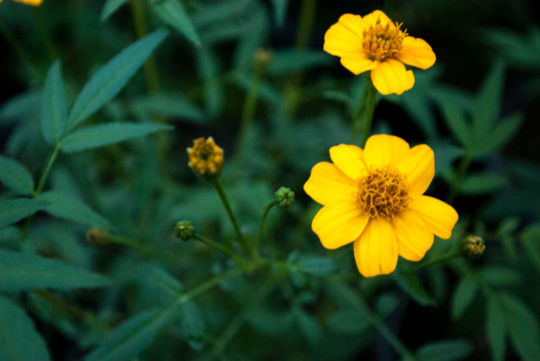
Vi invitiamo poi a tuffarvi nel mondo delle aromatiche, tantissime da annusare, vedere, assaggiare. Il nostro consiglio è unire l’utile al dilettevole, piante belle e buone... la più comune è il rosmarino, una bella presenza in piatti e giardini.
Ma volevamo scovare qualcosa di poco conosciuto e ci è venuta in mente questa bella pianta di produzione biologica (foto sopra): la Tagetes lemmonii anche detta Solero. Fiori giallo-arancio che colorano l’autunno e due modi interessanti di utilizzo: le foglie essiccate vengono utilizzate per insaporire minestre e salse e hanno un retrogusto di mela. Inoltre questa pianta può risultare utile al fine di prevenire gli attacchi delle lumache e di impedire la propagazione di erbe infestanti.
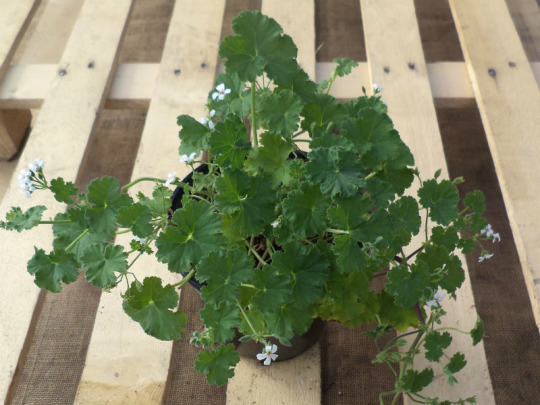
Per concludere, il geranio. Sì, ci sono gerani dalle foglie commestibili. Il nome corretto è in realtà Pelargonium e la varietà della foto é Bio e si chiama Pelargonium odoratissimum. Commestibile dal fresco aroma di mela, le sue foglie possono essere usate nella preparazione di macedonie, marmellate, tè, cocktails, limonate e come decorazione. Portamento compatto e delicata fioritura di colore bianco che comincia in primavera e arriva fino a tarda estate.
Visto che si avvicina il Natale, vi ricordiamo che queste piantine possono essere una perfetta idea regalo, soprattutto se ne selezionate una piccola collezione e la donate in una graziosa cassetta di legno.
Come sempre, ci vediamo su Yougardener.com.
0 notes
Text
PIXI FACIAL MISTS FOR EVERYONE!
I am loving the facial mists by Pixi! Pixi is a cruelty free brand, created by Petra Strand (born in Sweden) and available at Target. And yes: she has a mist for every skin type and need! Dry skin? Oily skin? You want to revive your skin, soothe, hydrate or nourish or simply that glow! Well, keep on reading and I am certain that you will find what you are looking for!
The Vitamin Wakeup Mist $15
What is it?
The Vitamin Wakeup Mist is a Vitamin boosting treatment toner that gives a revitalized awakened effect to the skin. The orange blossom water base is blended with skin-loving citrus fruit extracts, lavender, and arginine. This is my favorite of the 4 mists. I like to use it in the morning after I washed my face and it feels truly refreshing and gives me the great feel of putting something good on my skin. A refreshing mist full of vitamin power!
Who should use this?
Any skin type could use this, but I especially recommend it for combination to oily skin as this won´t add any greasiness.
Ingredients:
Water/Aqua/Eau, Citrus Aurantium Dulcis (Orange) Flower Water, Glycerin, Dipropylene Glycol, Butylene Glycol, Niacinamide, PEG-60 Hydrogenated Castor Oil, 1,2-Hexanediol, Caprylyl Glycol, Ethylhexylglycerin, Allantoin, Magnesium Ascorbyl Phosphate, Citric Acid, Sodium Citrate, Citrus Grandis (grapefruit) Peel Oil, Adenosine, Tropolone, Disodium EDTA, Arginine, Lavandula Angustifolia (Lavendar) Oil, Citrus Sinensis Peel Oil Expressed, Sodium Hyaluronate, Citrus Aurantifolia (Lime) Oil, Glycyrrhiza Glabra (Licorice) Root Extract, Sodium Starch Octenylsuccinate, Maltodextrin, Calcium Pantothenate, Sodium Ascorbyl Phosphate, Tocopheryl Acetate, Pryidoxine HCI, Silica.
The Hydrating Milky Mist $15
What is it?
The Hydrating Milky Mist is a featherlight mist that provides instant hydration with hyaluronic acid which literally plumps the skin. A blend of black oat, provitamin A, and linoleic acid makes this the perfect first layer of moisture before serums or makeup.
Who should use this?
I especially recommend this one for dry skin and for ladies beyond the 30 that have some fine lines kicking in as the Hyaluronic Acid helps to plump up those skin cells that are slowly getting weak!
Ingredients:
Water, Glycerin, Ethylhexyl Palmitate, Dipropylene Glycol, Cetyl Ethylhexanoate, Phenoxyethanol, Polyglyceryl-10 Oleate, Ethylhexylglycerin, PEG-60 Hydrogenated Castor Oil, Cetearyl Isononanoate, Allantoin, Ceteareth-20, Trideceth-10, Hydrolyzed Glycosaminoglycans, Hydrogenated Lecithin, Glyceryl Stearate, Ceteareth-12, Cetyl Alcohol, Stearyl Alcohol, Cetyl Palmitate, Disodium EDTA, Fragrance, Citric Acid, Benzoic Acid, Lecithin, Avena Strigosa Seed Extract.
The Glow Mist $15
What is it?
The Glow Mist gives an all-over glow for a radiant, dewy effect. With 13 oils and propolis, aloe vera and fruit extracts it is nourishing and moisturizing. This one you have to shake up to emulsify the oils to the right milky consistency!
Who should use this?
Ladies with dry skin or with normal skin that want that extra glow will profit from this Glow Mist! You can use it before your makeup application as an primer but you can also use it after your makeup application to get rid of the powdery look- or double up and use it before and after for that magic plump and hydrated glowy look!
Ingredients:
Water, Olea Europaea (Olive) Fruit Oil, Dipropylene Glycol, Butylene Glycol, Propolis Extract, Niacinamide, Argania Spinosa Kernel Oil, Aloe Barbadensis Leaf Extract, Betaine, Sodium Hyaluronate, PEG/PPG-17/6 Copolymer, Panthenol, Carthamus Tinctorius (Safflower) Seed Oil, Persea Gratissima (Avocado) Oil, Oenothera Biennis (Evening Primrose) Oil, Rosa Canina Fruit Oil, Simmondsia Chinensis (Jojoba) Seed Oil, Macadamia Integrifolia Seed Oil, 1,2-Hexanediol, Caprylyl Glycol, Illicium Verum (Anise) Fruit Extract, Adenosine, Rose Flower Oil, Tagetes Minuta Flower Oil, Mentha Arvensis Leaf Oil, Elettaria Cardamomum Seed Oil, Thymus Vulgaris (Thyme) Oil, Eugenia Caryophyllus (Clove) Leaf Oil, Melaleuca Alternifolia (Tea Tree) Leaf Oil, Vetiveria Zizanoides Root Oil, Cymbopogon Schoenanthus Oil, Pelargonium Graveolens Flower Oil, Lavandula Angustifolia (Lavender) Oil, Citrus Limon (Lemon) Peel Oil, Citrus Aurantium Dulcis (Orange) Peel Oil.
The Makeup Fixing Mist $15
What is it?
The Makeup Fixing Mist is an setting spray that will help you to get rid of that cakey/powdery makeup look and melt the makeup together. Spray it on as a last step in your makeup application and it adds a soft-focus finish. Or you could also mist it directly onto a makeup brush and apply your products (powders) as usual to prolong the wear. Rosewater and green tea at the same time hydrate and protect your skin.
Who should use it?
Any skin type can profit from this Makeup Fixing Mist. You can also use this before your makeup application as a skin treatment. Rosewater is full of vitamins and nutrients that are good for you!
Ingredients:
Water, Alcohol, Polyvinyl Alcohol, Ethylhexylglycerin, Rosa Centifolia Flower Water, Caprylyl Glycol, PEG-60 Hydrogenated Castor Oil, Sodium Citrate, Centella Asiatica Extract, Camellia Sinensis Leaf Extract, Trideceth-10, Caprylhydroxamic Acid, Glycerin, Chamaecyparis Obtusa Leaf Extract, Soleirolia Soleirolii Extract, Melissa Officinalis Leaf Extract, Origanum Majorana Leaf Extract, Fragrance, Butylene Glycol, Bambusa Vulgaris Extract, Pinus Densiflora Extract, Thuja Orientalis Extract, Salix Alba (Willow) Bark Extract, Origanum Vulgare Leaf Extract, Niacinamide, Lactobacillus/Soybean Ferment Extract, Cinnamomum Cassia Bark Extract, Scutellaria Baicalensis Root Extract, Portulaca Oleracea Extract, Maltodextrin, Ethyl Hexanediol, Calcium Pantothenate, Sodium Starch Octenylsuccinate, Polyquaternium-51, Sodium Ascorbyl Phosphate, Tocopheryl Acetate, Pyridoxine HCl, Silica.
Did you find the one that you want? Check them out at your local Target and grab one! ;-)
More information on: www.pixibeauty.com
Disclaimer: I received the products mentioned above for free. Regardless, I only recommend products or services I use personally and believe will be good for my readers. Contains Affiliate links. Read my full disclosure.
via Blogger http://ift.tt/2o41Pz7 http://ift.tt/2o3TWtA
0 notes
Note
Can I be your cringe unfollowable mutual in law?
Saw this last night and FORGOT anyways sure absolutely 👍 though my heads empty i cant remember which mutual we share? Im sure theres one but i can only vaguely remeber what the web of mutuals looks like on a good day
1 note
·
View note
Text
Phototoxic Essential Oils: What You Need To Know
I’ll admit it. When I first started using essential oils, I thought because they were “natural,” they were safe. I did very little research on them other than looking into the basics of how to use them. Thankfully, I mostly used them in homemade cleaning products and DIY skin care recipes, so most times they were properly diluted. No unfortunate peppermint bath experiences here, thank goodness!
Over the years, I’ve become a bit of a stickler for safe essential oil use, especially now that I know more about them. Essential oils are concentrated and strong. Not only that, but it often takes a lot of a plant to make a small amount of essential oil, and I want to be a good steward of the earth’s resources. In my efforts to use essential oils safely, one of the most recent safety concerns I’ve come across is phototoxicity.
If you’re familiar with essential oils, then I’m hoping you already know about phototoxic essential oils and are taking safety measures to avoid phototoxicity. However, if this is something you are not familiar with, I’d like to briefly explain what phototoxicity is, which essential oils are phototoxic, and how you can avoid it.
Phototoxicity 101
Phototoxicity can occur when constituents in certain essential oils (furocoumarins, most often) react when the skin is exposed to UV light. According to aromatherapist, Sheri Siegmund-Roach, the constituents in the essential oil binds with DNA in the skin cells and, once exposed to UV light, cell death and tissue damage occur (Siegmund-Roach, 2016).
Phototoxic reactions can occur anywhere from 1-3 days following exposure to UV light. These reactions often result in inflammation, swelling, blistering, and burned skin. Phototoxic reactions only occur when these oils are applied topically at specific dilutions (more on that below) and exposed to UV light within a 12-18 hour period.
Using phototoxic essential oils in diffusers and personal inhalers are fine. Some people even say these types of oils can be safely added to personal diffuser jewelry. However, I’d use some caution here, especially when it comes to jewelry that comes in contact with your skin such as lava beads and leather bands.
It is also believed that using phototoxic essential oils in skin care products that are washed off, like sugar scrubs, soaps, and shampoos, pose no risk of phototoxicity.
Phototoxic Essential Oils
So which essential oils are considered potentially phototoxic? Glad you asked. The following is a list of phototoxic and potentially phototoxic essential oils as well as a list of citrus essential oils that are not known to be phototoxic.
Phototoxic Essential Oils
Angelica root (Angelica glauca) essential oil
Bergamot (Citrus bergamia) essential oil, cold pressed
Bitter orange (Citrus x aurantium) essential oil, cold pressed
Cumin (Cuminum cyminum) essential oil
Lemon verbena (Aloysia triphylla) essential oil
Fig leaf (Ficus carica) absolute
Grapefruit (Citrus paradisi) essential oil, cold pressed
Lemon (Citrus limon) essential oil, cold pressed
Lime (Citrus aurantifolia) essential oil, cold pressed
Mandarin leaf (Citrus reticulata) essential oil
Opopanax (Commiphora erythraea) essential oil
Rue (Ruta graveolens) essential oil
Taget (Tagetes minuta) essential oil and absolute
Potentially Phototoxic Essential Oils
Clementine (Citrus clementina ) essential oil, cold pressed
Combava fruit (Citrus hystrix) essential oil
Skimmia (Skimmia japonica) essential oil
Angelica root (Angelica archangelica) absolute and CO2
Celery leaf (Apium graveolens) essential oil
Celery seed (Apium graveolens) absolute
Cumin seed (Cuminum cyminum) absolute and CO2
Khella (Ammi visnaga) essential oil
Lovage leaf (Levisticum officinale) essential oil
Parsnip (Pastinaca sativa) essential oil
Non-Phototoxic Citrus Essential Oils
Bergamot FCF (bergaptene- and furocoumarin-free) (Citrus bergamia) essential oil
Bergamot (Citrus bergamia) essential oil, steam distilled
Grapefruit (Citrus paradisi) essential oil, steam distilled
Lemon (Citrus limon) essential oil, steam distilled
Lime (Citrus aurantifolia) essential oil, steam distilled
Mandarin (Citrus reticulata) essential oil, cold pressed or steam distilled
Neroli (orange blossom) (Citrus x aurantium) essential oil
Sweet orange and blood orange (Citrus sinensis), cold pressed or steam distilled
Petitgrain bigarade (orange leaf) (Citrus x aurantium) essential oil
Satsuma (Cold Pressed or Steam Distilled)
Tangelo (Citrus reticulata) essential oil, cold pressed or steam distilled
Tangerine (Citrus reticulata) essential oil, cold pressed or steam distilled
Yuzu Oil (Citrus junos) essential oil, cold pressed or steam distilled
(Tisserand & Young, 2014)
How To Avoid Phototoxicity
In case you’re wondering, no, you don’t have to avoid all phototoxic essential oils like the plague during the summer. However, it is wise to know how to reduce the risk of phototoxicity if you do decide to use them.
First of all, your best bet at avoiding phototoxicity is to stay away from these oils. If that won’t work, try substituting steam distilled essential oils in their place or using these oils in diffusers and personal inhalers only, especially if you are regularly exposed to UV light.
If you do decide to use these types of essential oils, it’s recommended to wait 12-18 hours before exposing yourself to UV light. If you do have to go out, you should cover your skin with fairly thick clothes (light clothing doesn’t provide enough protection). This will ensure that the areas the essential oil was applied to are not exposed to the light. You can also dilute phototoxic essential oils to appropriate levels as well. Each oil has a recommended dilution guideline so you’ll definitely want to look into this closer if you do decide to go this route. You can find some of these phototoxic essential oil dilution guidelines here.
REFERENCES:
Siegmund-Roach, S. (2016). The truth about phototoxic essential oils and how to use them safely. Retrieved from http://bit.ly/2WPVWnn
Tisserand, R., & Young, R. (2014). Essential oil safety: A guide for health care professionals. (Second Edition). United Kingdom: Churchill Livingstone Elsevier.
This post was underwritten by Plant Therapy. All opinions are mine. Plant Therapy offers 100%, pure, undiluted essential oils sourced from some of the top essential oil suppliers in the world. They have single oils and synergy blends as well as a line of synergy blends specific to children. Not only do they offer high-quality essential oils, but they also offer carrier oils, hydrosols, and other essential oil accessories to help you keep yourself and your home naturally healthy.
The post Phototoxic Essential Oils: What You Need To Know appeared first on Growing Up Herbal.
Phototoxic Essential Oils: What You Need To Know published first on https://marcuskeever.blogspot.com/
0 notes
Text
Phototoxic Essential Oils: What You Need To Know
I’ll admit it. When I first started using essential oils, I thought because they were “natural,” they were safe. I did very little research on them other than looking into the basics of how to use them. Thankfully, I mostly used them in homemade cleaning products and DIY skin care recipes, so most times they were properly diluted. No unfortunate peppermint bath experiences here, thank goodness!
Over the years, I’ve become a bit of a stickler for safe essential oil use, especially now that I know more about them. Essential oils are concentrated and strong. Not only that, but it often takes a lot of a plant to make a small amount of essential oil, and I want to be a good steward of the earth’s resources. In my efforts to use essential oils safely, one of the most recent safety concerns I’ve come across is phototoxicity.
If you’re familiar with essential oils, then I’m hoping you already know about phototoxic essential oils and are taking safety measures to avoid phototoxicity. However, if this is something you are not familiar with, I’d like to briefly explain what phototoxicity is, which essential oils are phototoxic, and how you can avoid it.
Phototoxicity 101
Phototoxicity can occur when constituents in certain essential oils (furocoumarins, most often) react when the skin is exposed to UV light. According to aromatherapist, Sheri Siegmund-Roach, the constituents in the essential oil binds with DNA in the skin cells and, once exposed to UV light, cell death and tissue damage occur (Siegmund-Roach, 2016).
Phototoxic reactions can occur anywhere from 1-3 days following exposure to UV light. These reactions often result in inflammation, swelling, blistering, and burned skin. Phototoxic reactions only occur when these oils are applied topically at specific dilutions (more on that below) and exposed to UV light within a 12-18 hour period.
Using phototoxic essential oils in diffusers and personal inhalers are fine. Some people even say these types of oils can be safely added to personal diffuser jewelry. However, I’d use some caution here, especially when it comes to jewelry that comes in contact with your skin such as lava beads and leather bands.
It is also believed that using phototoxic essential oils in skin care products that are washed off, like sugar scrubs, soaps, and shampoos, pose no risk of phototoxicity.
Phototoxic Essential Oils
So which essential oils are considered potentially phototoxic? Glad you asked. The following is a list of phototoxic and potentially phototoxic essential oils as well as a list of citrus essential oils that are not known to be phototoxic.
Phototoxic Essential Oils
Angelica root (Angelica glauca) essential oil
Bergamot (Citrus bergamia) essential oil, cold pressed
Bitter orange (Citrus x aurantium) essential oil, cold pressed
Cumin (Cuminum cyminum) essential oil
Lemon verbena (Aloysia triphylla) essential oil
Fig leaf (Ficus carica) absolute
Grapefruit (Citrus paradisi) essential oil, cold pressed
Lemon (Citrus limon) essential oil, cold pressed
Lime (Citrus aurantifolia) essential oil, cold pressed
Mandarin leaf (Citrus reticulata) essential oil
Opopanax (Commiphora erythraea) essential oil
Rue (Ruta graveolens) essential oil
Taget (Tagetes minuta) essential oil and absolute
Potentially Phototoxic Essential Oils
Clementine (Citrus clementina ) essential oil, cold pressed
Combava fruit (Citrus hystrix) essential oil
Skimmia (Skimmia japonica) essential oil
Angelica root (Angelica archangelica) absolute and CO2
Celery leaf (Apium graveolens) essential oil
Celery seed (Apium graveolens) absolute
Cumin seed (Cuminum cyminum) absolute and CO2
Khella (Ammi visnaga) essential oil
Lovage leaf (Levisticum officinale) essential oil
Parsnip (Pastinaca sativa) essential oil
Non-Phototoxic Citrus Essential Oils
Bergamot FCF (bergaptene- and furocoumarin-free) (Citrus bergamia) essential oil
Bergamot (Citrus bergamia) essential oil, steam distilled
Grapefruit (Citrus paradisi) essential oil, steam distilled
Lemon (Citrus limon) essential oil, steam distilled
Lime (Citrus aurantifolia) essential oil, steam distilled
Mandarin (Citrus reticulata) essential oil, cold pressed or steam distilled
Neroli (orange blossom) (Citrus x aurantium) essential oil
Sweet orange and blood orange (Citrus sinensis), cold pressed or steam distilled
Petitgrain bigarade (orange leaf) (Citrus x aurantium) essential oil
Satsuma (Cold Pressed or Steam Distilled)
Tangelo (Citrus reticulata) essential oil, cold pressed or steam distilled
Tangerine (Citrus reticulata) essential oil, cold pressed or steam distilled
Yuzu Oil (Citrus junos) essential oil, cold pressed or steam distilled
(Tisserand & Young, 2014)
How To Avoid Phototoxicity
In case you’re wondering, no, you don’t have to avoid all phototoxic essential oils like the plague during the summer. However, it is wise to know how to reduce the risk of phototoxicity if you do decide to use them.
First of all, your best bet at avoiding phototoxicity is to stay away from these oils. If that won’t work, try substituting steam distilled essential oils in their place or using these oils in diffusers and personal inhalers only, especially if you are regularly exposed to UV light.
If you do decide to use these types of essential oils, it’s recommended to wait 12-18 hours before exposing yourself to UV light. If you do have to go out, you should cover your skin with fairly thick clothes (light clothing doesn’t provide enough protection). This will ensure that the areas the essential oil was applied to are not exposed to the light. You can also dilute phototoxic essential oils to appropriate levels as well. Each oil has a recommended dilution guideline so you’ll definitely want to look into this closer if you do decide to go this route. You can find some of these phototoxic essential oil dilution guidelines here.
REFERENCES:
Siegmund-Roach, S. (2016). The truth about phototoxic essential oils and how to use them safely. Retrieved from http://bit.ly/2WPVWnn
Tisserand, R., & Young, R. (2014). Essential oil safety: A guide for health care professionals. (Second Edition). United Kingdom: Churchill Livingstone Elsevier.
This post was underwritten by Plant Therapy. All opinions are mine. Plant Therapy offers 100%, pure, undiluted essential oils sourced from some of the top essential oil suppliers in the world. They have single oils and synergy blends as well as a line of synergy blends specific to children. Not only do they offer high-quality essential oils, but they also offer carrier oils, hydrosols, and other essential oil accessories to help you keep yourself and your home naturally healthy.
The post Phototoxic Essential Oils: What You Need To Know appeared first on Growing Up Herbal.
Phototoxic Essential Oils: What You Need To Know published first on https://marcuskeever.blogspot.com/
0 notes